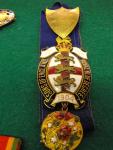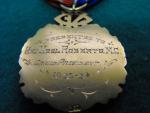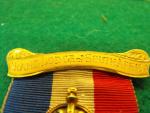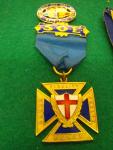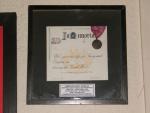
sabrigade
For Deletion-
Posts
1,707 -
Joined
-
Last visited
-
Days Won
34
Content Type
Profiles
Forums
Blogs
Gallery
Events
Store
Everything posted by sabrigade
-
There are at least 3 known WW1 MC groups awarded to WW1 South African chaplains. One of the better known decorated WW1 South African recipients was Padre Eustace Hill. The study of the Africa Service Medal and its prefixes is a specialised subject or topic. No number and the name only on a Africa Service Medal indicates that the recipient was an officer in the ACF or Active Citizen Force. Your comment regarding the V prefix is therefore not correct. " ACF Other Ranks serving in the part-time Active Citizen Force (The units listed in the Register include NVB, R&H Bde, MEB, UTC, SACS, SANF®, MTC, CDC, SAGA. SAEC, SAA, MOTA, and others)"
-
This appears to be gold and enamel badge of office. “The ‘Sons of England’ were a patriotic and benevolent society for British ex-patriots living in Canada and South Africa. The Society’s first lodge was founded in Toronto, 1874 and other lodges were soon established throughout Canada and later in South Africa. Their organisation was modeled on freemasonry so their regalia and customs reflect this. It was quite usual for Benevolent and Mutual Societies of the time to model their organisational structures on the Freemasons. The last ‘Sons of England’ lodge closed in Canada during 1971. As a mutual benefit society members would pay their weekly subscriptions and in return they and their families could benefit in times of need, such as unemployment assistance, disability benefits, medical fees and funeral costs. Social evenings amongst member’s families and travel outings were also an important aspect of membership that helped engender a strong sense of camaraderie. The ethos of the Society was to keep alive the old traditions of ‘home ‘and celebrate ‘England’s Greatness’.”
-
Naming on the Africa Service Medal. This was awarded to Union service volunteer personnel who served at home and abroad during World War 2 for at least 30 days. "ACF" prefix stands for Active Citizen Force. Recipients had signed an oath to voluntary serve anywhere in Africa and this was later extended to other areas outside the Union of South Africa.
-
Military Cross citation: "SUPPLEMENT TO THE LONDON GAZETTE, 4 OCTOBER 1919 Rev, Noel Roberts, T./C.F., 4th Class, R.A.C.D., attd. 1st Bn., S. Afr.Infy. During the operations from the 8th/9th October, 1918, east of Beaurevoir, and at Le Cateau, he showed great energy and devotion to duty in organising strectcher-bearer parties and bringing in wounded under very heavy fire to a place of safety. His contempt of danger was most marked, and through his gallant efforts all wounded and dead were brought back with very little delay."
-
The Reverend Roberts was educated at St Augustine’s College in Canterbury from 1903 to 1906. He became Deacon in 1906 and Priest of Pretoria in 1908. At the same time, he was also the Curate of St Albans in Pretoria from 1906 to 1912. He then became Vicar of Pietersburg from 1912 to 1915. The Reverend then attested in the Chaplain Services and was temporary commissioned in 1917 as a Chaplain to the Forces, 4th Class. He was attached to the 1st South African Infantry Regiment and was awarded the Military Cross for his participation in the operations that took place on 8 and 9 October 1918.
-
The certificate that accompanied the medal for services rendered. Private Mahon survived the Battle of Delville Wood and was discharged a year later for being "under age". He was wounded during the Senussi caampaign in North Africa before he went to France with the 1st South African Infantry Brigade.
-
They did give out a next-of-kin certificate to the family of soldiers who did not return, so possibly a medal accompanied the certificate? A certificate also accompanied the award of the recruiting medal. I have both examples of the certificate in my collection and will attempt to get scans sent to me so that I can post them on the forum.
-
The 1st and 2nd Military Constabulary each had four mounted squadrons. They were formed effectively on 3 November 1915 and conducted policing and garrison duty in German South West Africa. This took place after the five South African Mounted Regiments were withdrawn from the territory. The Constabulary acted as a military/militarised police force for rural policing and saw service on the border of Angola against tribal rebels, criminals and remnants of the German/Boer rebels. The units were disbanded on 30 June 1920.
-
The Endley Collection : Part 1 : The Sudan and Iraq
sabrigade replied to sabrigade's topic in Middle East & Arab States
Thanks David, As you know, it never ends! Regards, Will



